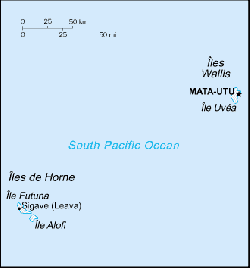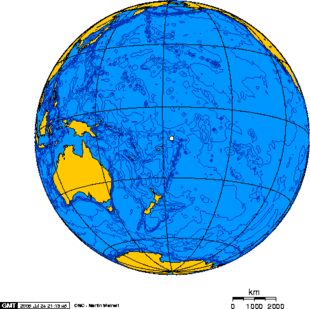Wallis and Futuna
| Territoire de Wallis et Futuna | ||||||
|---|---|---|---|---|---|---|
|
||||||
| Motto: n/a | ||||||
| Anthem: La Marseillaise |
||||||
| Capital (and largest city) | Mata-Utu 13°20′S 176°20′W | |||||
| Official languages | French, Other: ʻUvean, Futunan |
|||||
| Government | Overseas territory of France | |||||
| - | President | Jacques Chirac | ||||
| - | Administrator-Superior | Xavier de Furst | ||||
| - | President of the Territorial Assembly | Patalione Kanimoa | ||||
| - | Kings Traditionally three: | Tomasi Kulimoetoke II, king of Uvea 1959– Soane Patita Maituku, king of Tu´a (Alo) 2002– Visesio Moeliku, king of Sigave 2004– |
||||
| Non-sovereign | overseas territory of France | |||||
| - | Date | 1959 Voted to be a territory of France | ||||
| Area | ||||||
| - | Total | 274 km² (211th) 106 sq mi |
||||
| - | Water (%) | Negligible | ||||
| Population | ||||||
| - | July 2005 estimate | 15,480 (218th) | ||||
| - | 2003 census | 14,944 | ||||
| GDP (PPP) | 2004 estimate | |||||
| - | Total | $60 million (226th) | ||||
| - | Per capita | $ 3,800 (149th) | ||||
| Currency | CFP franc (XPF) |
|||||
| Time zone | (UTC+12) | |||||
| Internet TLD | .wf | |||||
| Calling code | +681 | |||||
Wallis and Futuna, officially the Territory of Wallis and Futuna Islands (French: Wallis et Futuna or Territoire des îles Wallis et Futuna), is a group of three volcanic tropical islands (Wallis (Uvea), Futuna, and Alofi with fringing reefs located in the South Pacific Ocean between Fiji and Samoa.
Administration
Wallis and Futuna has been a French overseas collectivity (French: collectivité d'outre-mer, or COM) since 2003. Between 1961 and 2003, it had the status of an overseas territory (French: territoire d'outre-mer, or TOM).
History
Although they were discovered by the Dutch and the British in the 17th and 18th centuries, it was the French who were the first Europeans to settle in the territory, with the arrival of French missionaries in 1837, who converted the population to Catholicism. Wallis is named after the Cornish explorer Samuel Wallis.
On April 5, 1842, they asked for the protection of France after the rebellion of a part of the local population. On April 5, 1887, the queen of Uvea (on the island of Wallis) signed a treaty officially establishing a French protectorate. The kings of Sigave and Alo on the islands of Futuna and Alofi also signed a treaty establishing French protectorate on February 16, 1888. The islands were put under the authority of the French colony of New Caledonia.
In 1917, the three traditional chiefdoms were annexed to France and turned into the Colony of Wallis and Futuna, still under the authority of the Colony of New Caledonia.
In 1959, the inhabitants of the islands voted to become a French overseas territory, effective in 1961, thus ending their subordination to New Caledonia.
Politics
The territory is divided into three traditional chiefdoms (royaumes coutumiers): Uvea (on the island of Wallis), Sigave (on the western part of the island of Futuna), and Alo (on the island of Alofi and on the eastern part of the island of Futuna). Uvea is further subdivided into three districts: Hanake, Hihifo, and Mua. The capital of the territory is Mata-Utu on the island of Wallis (the most populated island). As a territory of France, it is governed under the French constitution of September 28, 1958, uses the French legal system, and suffrage is universal for those over 18 years of age. The French president elected by popular vote for a five-year term; the high administrator is appointed by the French president on the advice of the French Ministry of the Interior; the presidents of the Territorial Government and the Territorial Assembly are elected by the members of the assembly.
The head of state is President Jacques Chirac of France as represented by High Administrator Xavier de Furst (since January 18, 2005). The head of government is President of the Territorial Assembly Patalione Kanimoa (since January 2001. The Council of the Territory consists of three kings (kings of the three traditional chiefdoms) and three members appointed by the high administrator on the advice of the Territorial Assembly.
The legislative branch consists of the unicameral Territorial Assembly or Assemblée territoriale of 20 seats; the members are elected by popular vote to serve five-year terms. Wallis and Futuna elects one senator to the French Senate and one deputy to the French National Assembly.
Justice is generally administered under French law by a tribunal of first instance in Mata-Utu, but the three traditional chiefdoms administer justice according to customary law (only for non-criminal cases). The court of appeal is in Nouméa, New Caledonia.
The territory participates in the Franc Zone, and Secretariat of the Pacific Community.
Geography
Wallis and Futuna is located about two-thirds of the way from Hawaii to New Zealand, at 13°18′S 176°12′W.
The territory includes the island of Wallis (the most populated), the island of Futuna, the uninhabited island of Alofi (the population of Alofi was reportedly eaten by the cannibal people of Futuna in one single raid in the 19th century), and 20 uninhabited islets, totaling 274 square kilometres (106 sq mi) with 129 kilometres (80 mi) of coastline. The highest point in the territory is Mont Singavi (on the island of Futuna) at 765 metres (2,510 ft).
The islands have a hot, rainy season from November to April and a cool, dry season from May to October. The rains accumulate 2,500 to 3,000 millimeters (98–118 in) each year. The average humidity is 80% and the temperature 26.6°C (79.9°F).
Only five percent of the islands' land area is arable land; permanent crops cover another 20%. Deforestation (only small portions of the original forests remain), largely as a result of the continued use of wood as the main fuel source, is a serious problem; as a consequence of cutting down the forests, the mountainous terrain of Futuna is particularly prone to erosion. There are no permanent settlements on Alofi because of the lack of natural fresh water resources.
Economy
The territory's economy is limited to traditional subsistence agriculture, with about 80% of the labor force earning its livelihood from agriculture (coconuts and vegetables), livestock (mostly pigs), and fishing. About 4% of the population is employed in government. Revenues come from French Government subsidies, licensing of fishing rights to Japan and South Korea, import taxes, and remittances from expatriate workers in New Caledonia.
The gross domestic product had in 1995 a purchasing power parity of about $28.7 million total, about $2,000 per capita. The territory takes in about $20 million per year in revenues against about $17 million in expenditures.
Industries include copra, handicrafts, fishing, and lumber. Agricultural products include breadfruit, yams, taro, bananas, pigs, and goats. In 1995, about $370,000 worth of commodities (copra, breadfruit, yams, taro roots, handicrafts) were exported, and about $13.5 million worth of commodities (foodstuffs, manufactured goods, transportation equipment, fuel, clothing) were imported, primarily from France, Australia, and New Zealand.
The territory uses the CFP Franc, along with the French territories of New Caledonia and French Polynesia; the CFP franc (XPF) is fixed vs. the euro, at the rate of 1,000 XPF = 8.38 euro.
Demographics
The total population of the territory at the 2003 census was 14,944 (67.4% on the island of Wallis, 32.6% on the island of Futuna), the vast majority of Polynesian ethnicity, with a small minority of French descent. More than 16,000 Wallisians and Futunians live as expatriates in New Caledonia, which is more than the total population of Wallis and Futuna. The overwhelming majority of the people in Wallis and Futuna are Catholic. They speak both French and Wallisian or Futunian, the indigenous Polynesian languages. However, French is only spoken by 10% of the population as a first language. Half the total population (both men and women) age 15 and over can read and write.
Culture
The culture of those islands is typically Polynesian. Most notably, the Music of Wallis and Futuna has a rich tradition.
The Kailao, often thought of as a Tongan war dance was imported to Tonga from 'Uvea.
Transportation & Communications
In 1994, the territory had 1,125 telephones in use, had one AM radio station, and two television broadcast stations.
The island of Wallis has about 100 kilometers (62 mi) of highway, 16 paved, while the island of Futuna has only 20 kilometers (12.5 mi), none of it paved. The territory has two main ports and harbors, Leava (on the island of Futuna), and Mata-Utu, that support its merchant marine fleet consisting of three ships totaling 92,060 GRT or 45,881 DWT: two passenger ships and a petroleum tanker. There are two airports, one with a paved runway about 2,000 meters (6,600 ft) long, one with a 1,000-meter (3,300 ft) unpaved strip.
The only commercial flights that go to Wallis are operated by the New Caledonia based Aircalin. There is an Aircalin office in Mata-Utu on Wallis. There are no commercial boat operators.
Miscellaneous
The territory's data code and country code (top level Internet domain) is WF.
See also
- French overseas departments and territories
- Administrative divisions of France
- Islands controlled by France in the Indian and Pacific oceans
- Vicariate Apostolic of Oriental Oceania
External links
- Open Directory Project - Wallis and Futuna directory category
- World Statesmen - Wallis and Futuna politics and government
- GeoHive - Wallis and Futuna Islands population of districts and villages
- Map of Wallis and Futuna
- Map of Wallis and Futuna, with district boundaries
- (French) Information about Wallis and Futuna
- (French) Uvea mo Futuna Wallis and Futuna online magazine
- (French) Pictures of Wallis
- (French) Statistics of Wallis and Futuna
Template:Overseas french departements
Template:Polynesia
Template:Pacific Islands
zh-min-nan:Wallis kap Futuna be:Выспы Ўоліс і Футуна bg:Уолис и Футуна ca:Wallis i Futuna cs:Wallis a Futuna da:Wallis-og-Futuna de:Wallis und Futuna el:Ουώλλις και Φουτούνα es:Wallis y Futuna eo:Valiso kaj Futuno eu:Wallis eta Futuna fr:Wallis-et-Futuna ga:Vailís agus Futúna gl:Wallis e Futuna ko:월리스 푸투나 hr:Wallis i Futuna io:Wallis e Futuna Insuli id:Wallis dan Futuna is:Wallis- og Fútúnaeyjar it:Wallis e Futuna he:ואליס ופוטונה lv:Volisa un Futūna lt:Volis ir Futūna hu:Wallis és Futuna nl:Wallis en Futuna ja:ウォリス・フツナ no:Wallis og Futuna pl:Wallis i Futuna pt:Wallis e Futuna ru:Острова Уоллис и Футуна sk:Wallis a Futuna sr:Валис и Футуна sh:Wallis i Futuna fi:Wallis- ja Futunasaaret sv:Wallis- och Futunaöarna tr:Wallis ve Futuna Adaları zh:瓦利斯及富圖納群島



